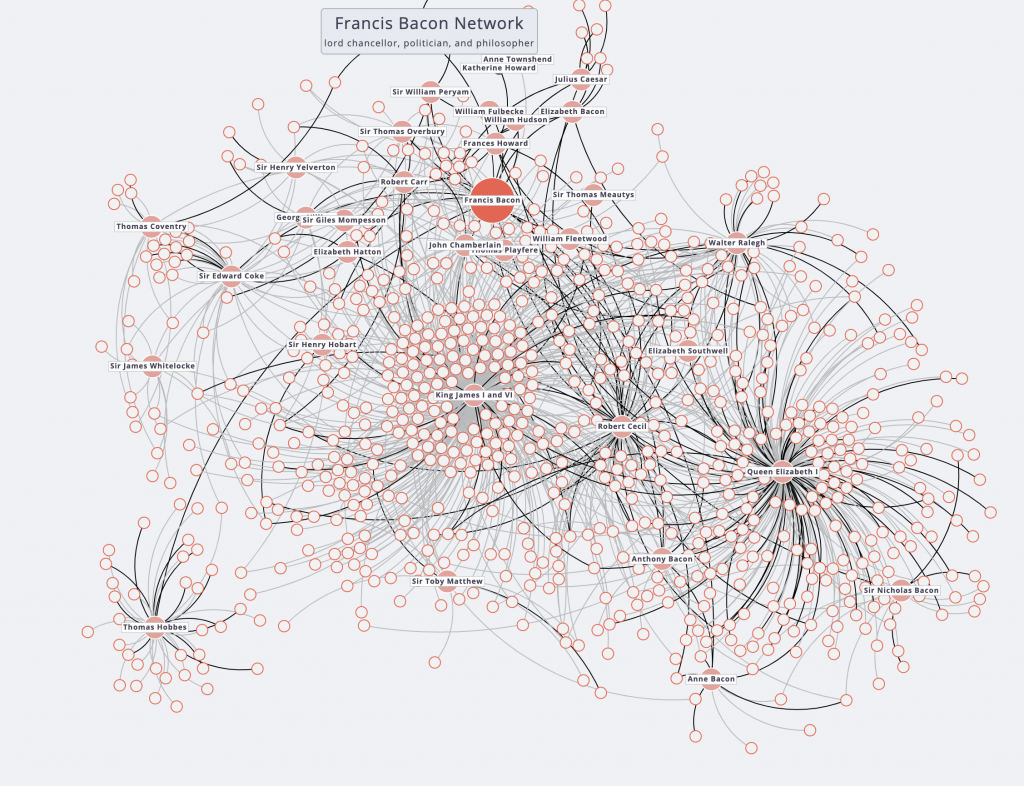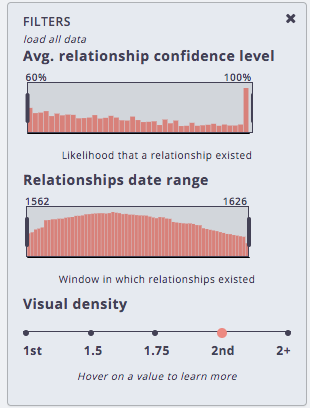
Francis Bacon, esteemed Elizabethan philosopher, father of empiricism, and notorious pain in my rear during my 10th grade AP European History class, undoubtedly left his legacy in history. However, his place in early modern British society — particularly within his connections to other notable figures of the era— serves as the lens through which anyone visiting Six Degrees of Francis Bacon can analyze the period’s mass social networks à la a similar process for a famous Kevin of the same surname. The digital tool connects Francis Bacon to big names of the 16th and 17th century like King James IV and Thomas Hobbes, along with “friend-of-a-friend” type figures, like physicist Henry Stubbe or scholar Patrick Young.

Sources
The site’s sources seem to stem from all across both the web and the library database alike. Since the program is open access and allows for new, historically accurate connections to be made at any time by anyone, some of the information stems from a myriad of contributors, each with various biographies or historical texts to back up their claims, as well as to provide a relative level of confidence in the likelihood of the relationship. Some of these sources include scholarly articles, digitally published biographies, and other publications, many of which found on JStor, the Oxford Dictionary of National Biographies or Google Scholar — all of which are linked on the platform after clicking on any listed person. Furthermore, the administrators of the website also include connections sourced from “statistical inference.” The inference for these connections is determined by an R code sourced from the SDFB Network repo and the Oxford Dictionary of National Biographies. Data sets from these relations, as well as ones from relations added by human contributors, may be found and exported for non-commercial use.
Processes
The process of turning the source data into the data visualization presented to the viewer involves the transition of the source data into code. Since most of the information is already digitized (as most of it is available through digital sources), the processing period includes determining the level of confidence for the listed networks and organizing the people listed based on various group connections (eg. judges, benefactors) which can be isolated and can serve as their own means of relation.
Presentation
With all of the information acquired and adjusted to fit the needs and design of the project, the date is transformed into a visualized web of sorts, with connections between Francis Bacon and others in early modern Britain linked by lines, black to represent human contribution or grey to represent statistical inference, with the degree of separation from Bacon reflected by the color of the circle representing each person. The map can also be toggled to be viewed as either a Hooke view or a Concentric view, with either making clear and accessible the over 200,000 relationships catalogued on the site. The data visualization is highly interactive. A visitor of the sight could change the origin from Bacon to another listed member of the society represented, and instead view only those with connections to that person, utilizing the same visual cues to reflect degree of separation and source of data. Furthermore, one could isolate the link between any two people and see who they each knew, thus allowing a person to view the scope of communities within the society, and searching up individuals is easily accomplished. Each group also has a timeline view, which allows users to find the birth and death years of members within those particular groups. The entire site utilizes Angular, Ruby on Rails, and D3 code to execute the visualization.

DH is Better With Bacon
The project aims not only to make easy searchable and accessible these historical connections, but seeks to allow for expansion, critique and revision of the project in the spirit of collaboration. Touching on the fields of history, British Studies, philosophy, and social science, the data visualization successfully encapsulates Bacon’s period, and with it a period of rich writing, epic history, and enlightenment ideas. The creation of the original website was led by project director Christopher Warren and co-PIs Daniel Shore, Jessica Otis, Scott B. Weingart, and John Ladd and is hosted by Carnegie Mellon University Libraries.
One reply on “Don’t Worry, Francis Bacon Knows a Guy”
I think that the visual that the site has helps communicate just how many connections this guy has. It’s like when you think of a billion dollars, you don’t realize just how much it is until you see a visual.